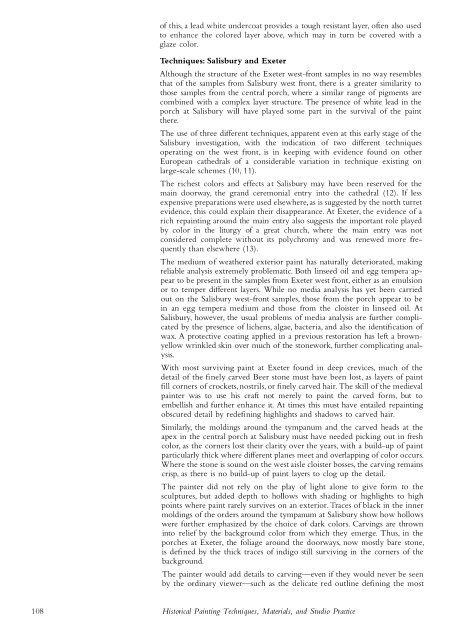Historical Painting Techniques, Materials, and Studio Practice
Create successful ePaper yourself
Turn your PDF publications into a flip-book with our unique Google optimized e-Paper software.
of this, a lead white undercoat provides a tough resistant layer, often also used<br />
to enhance the colored layer above, which may in turn be covered with a<br />
glaze color.<br />
<strong>Techniques</strong>: Salisbury <strong>and</strong> Exeter<br />
Although the structure of the Exeter west-front samples in no way resembles<br />
that of the samples from Salisbury west front, there is a greater similarity to<br />
those samples from the central porch, where a similar range of pigments are<br />
combined with a complex layer structure. The presence of white lead in the<br />
porch at Salisbury will have played some part in the survival of the paint<br />
there.<br />
The use of three different techniques, apparent even at this early stage of the<br />
Salisbury investigation, with the indication of two different techniques<br />
operating on the west front, is in keeping with evidence found on other<br />
European cathedrals of a considerable variation in technique existing on<br />
large-scale schemes (10, 11).<br />
The richest colors <strong>and</strong> effects at Salisbury may have been reserved for the<br />
main doorway, the gr<strong>and</strong> ceremonial entry into the cathedral (12). If less<br />
expensive preparations were used elsewhere, as is suggested by the north turret<br />
evidence, this could explain their disappearance. At Exeter, the evidence of a<br />
rich repainting around the main entry also suggests the important role played<br />
by color in the liturgy of a great church, where the main entry was not<br />
considered complete without its polychromy <strong>and</strong> was renewed more frequently<br />
than elsewhere (13).<br />
The medium of weathered exterior paint has naturally deteriorated, making<br />
reliable analysis extremely problematic. Both linseed oil <strong>and</strong> egg tempera appear<br />
to be present in the samples from Exeter west front, either as an emulsion<br />
or to temper different layers. While no media analysis has yet been carried<br />
out on the Salisbury west-front samples, those from the porch appear to be<br />
in an egg tempera medium <strong>and</strong> those from the cloister in linseed oil. At<br />
Salisbury, however, the usual problems of media analysis are fu rther complicated<br />
by the presence of lichens, algae, bacteria, <strong>and</strong> also the identification of<br />
wax. A protective coating applied in a previous restoration has left a brownyellow<br />
wrinkled skin over much of the stonework, fu rther complicating anal<br />
YSlS.<br />
With most surviving paint at Exeter found in deep crevices, much of the<br />
detail of the finely carved Beer stone must have been lost, as layers of paint<br />
fill corners of crockets, nostrils, or finely carved hair. The skill of the medieval<br />
painter was to use his craft not merely to paint the carved form, but to<br />
embellish <strong>and</strong> further enhance it. At times this must have entailed repainting<br />
obscured detail by redefining highlights <strong>and</strong> shadows to carved hair.<br />
Similarly, the moldings around the tympanum <strong>and</strong> the carved heads at the<br />
apex in the central porch at Salisbury must have needed picking out in fresh<br />
color, as the corners lost their clarity over the years, with a build-up of paint<br />
particularly thick where different planes meet <strong>and</strong> overlapping of color occurs.<br />
Where the stone is sound on the west aisle cloister bosses, the carving remains<br />
crisp, as there is no build-up of paint layers to clog up the detail.<br />
The painter did not rely on the play of light alone to give form to the<br />
sculptures, but added depth to hollows with shading or highlights to high<br />
points where paint rarely survives on an exterior. Traces of black in the inner<br />
moldings of the orders around the tympanum at Salisbury show how hollows<br />
were further emphasized by the choice of dark colors. Carvings are thrown<br />
into relief by the background color from which they emerge. Thus, in the<br />
porches at Exeter, the foliage around the doorways, now mostly bare stone,<br />
is defined by the thick traces of indigo still surviving in the corners of the<br />
background.<br />
The painter would add details to carving-even if they would never be seen<br />
by the ordinary viewer-such as the delicate red outline defining the most<br />
108<br />
<strong>Historical</strong> <strong>Painting</strong> <strong>Techniques</strong>, <strong>Materials</strong>, <strong>and</strong> <strong>Studio</strong> <strong>Practice</strong>


